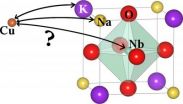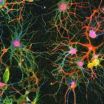(Press-News.org) HOUSTON – (Nov. 18, 2010) – Discovery of a fifth gene defect and the identification of 47 DNA regions linked to thoracic aortic disease are the subject of studies released this month involving researchers at The University of Texas Health Science Center at Houston (UTHealth).
In both studies, the investigators have identified alterations in the genetic material or DNA that affect the ability of smooth muscle cells, which line the aorta and other blood vessels, to contract. This can lead to a weakening of the wall of the aorta, the main blood vessel leading out of the heart. One of the studies was published in the November issue and the other was published online today in the American Journal of Human Genetics.
"Both discoveries are more confirmation of the role that proper contraction of smooth muscle cells has on the aorta and they increase our knowledge of the pathway of the disease," said Dianna M. Milewicz, M.D., Ph.D., a senior author of both studies, professor and the President George H.W. Bush Chair in Cardiovascular Research and director of the Division of Medical Genetics at The University of Texas Medical School at Houston, part of UTHealth. "That allows us to figure out how to potentially block or reverse the disease, which is our ultimate goal."
In thoracic aortic disease, the deterioration of the wall of the aorta can cause an aneurysm, or ballooning of the vessel, that can lead to dissection or rupture and sudden death. If caught early enough, people with the familiar genetic defect can take medications and/or undergo surgery to repair the damage. An estimated 8,000 people die annually from thoracic aortic disease.
Using the UTHealth database of more than 600 families affected by thoracic aortic disease, Milewicz and her research team members have previously identified four gene defects associated with the familial form of the disease, which runs in families. Of people who have the disease, 20 percent have the familial form. The aortas of family members who test positive for the gene defect can be routinely scanned, monitored and repaired, saving lives. Research continues through the John Ritter Research Program at UTHealth, founded by his widow Amy Yasbeck. The beloved actor died from a thoracic aortic dissection.
The discovery of the fifth gene defect is reported in the article "Mutations in Myosin Light Chain Kinase (MYLK) Cause Familial Aortic Dissections." Kinases act on proteins, transmitting signals and controlling complex processes in cells. MYKL is a kinase that controls the contraction of smooth muscle cells. In families with genetic alterations or mutations in this gene, the kinase does not work properly, leading eventually to the weakening in the wall of the aorta.
The second article deals with entire regions of the DNA with variants linked to the disease, but in people who do not have the familial form of thoracic aortic aneurysms.
"These are regions of the DNA where genes are missing or there might be three copies of a region of DNA instead of two," Milewicz said. "We don't understand these types of variations in the DNA yet because we all having missing or duplicated regions of DNA and these variants seems to be all over the genome. In patients with thoracic aortic disease, these regions of DNA that are missing or an extra copy is present appear to disrupt the smooth muscle cells and their ability to contract or gain a 'footing' to contract properly. These gene variants, combined with environmental factors, could result in a predisposition to thoracic aortic disease."
Co-senior author of the article with Milewicz is John W. Belmont, M.D., Ph.D., professor of molecular medicine and human genetics at Baylor College of Medicine (BCM). Colleagues from UTHealth and BCM did a genome-wide analysis of thoracic aortic aneurysms and dissections in 418 patients. They identified 47 variant regions that were unique to these patients.
"For a long time, we concentrated on single mutations that would, by themselves, cause disease. "Now we have come up with a new paradigm where we see different types of mutations – rare mutations. Instead of one gene, dozens of genes may be involved in the disease and each gene variant may account for a few cases. Together, they affect a common biological mechanism that causes the disease," said Siddharth Prakash, assistant professor of molecular and human genetics at BCM and first author of "Rare Copy Variants Disrupt Genes Regulating Vascular Smooth Muscle Cell Adhesion and Contractibility in Sporadic Thoracic Aortic Aneurysms and Dissections."
INFORMATION:
UTHealth co-authors of the MYLK discovery paper are Li Wang, School of Biomedical Sciences; Dong-chaun Guo, Ph.D., assistant professor in internal medicine ; Jiumei Cao, post-doctoral fellow; Limin Gong, Ph.D., assistant professor in internal medicine; Ellen Regalado, genetic counselor; and Li Li, research associate with the Institute of Molecular Medicine. Other collaborative authors are from The University of Texas Southwestern Medical School, Dallas; The University of Texas M.D. Anderson Cancer Center, Houston; Nanjing University, China; Max-Planck-Institute for Heart and Lung Research, Bad Nauheim, Germany; University of Alberta, Edmonton, Canada; and Yale University.
UTHealth co-authors of the study on DNA copy variants are Guo; Regalado; Hossein Golabbakhsh of the School of Public Health; Ralph J. Johnson, Ph.D., assistant professor of internal medicine; Hazim Safi, M.D., professor and chair of the Department of Cardiothoracic and Vascular Surgery; and Anthony L. Estrera, M.D., associate professor of cardiothoracic and vascular surgery.
Funding for the studies came from the National Institutes of Health, the Vivian L. Smith Foundation, the Tex-Gen Foundation, the Doris Duke Foundation and the Thoracic Surgery Foundation for Research and Education.
END
Technical progress in the automobile industry is unbroken. But, the sector has still some hard nuts to crack: "Lead-free materials" is one of the challenges – hidden behind this challenge is a EU environmental directive which, based on a step-by-step plan, gradually bans all lead-containing materials and components from automotive vehicles – such as piezoelectric components. These elements are important for diesel engine injectors, for example, which control the supply of fuel to the combustion chamber.
The problem: Up to now lead-zirconate-titanate (PZT) is the material ...
A short push on the light switch – and the whole ceiling lights up in a uniform and pleasant color. This "illuminated sky" is not available as yet, but researchers from all over the world are working on it flat out. The technology behind this marvel is based on organic light-emitting diodes, or OLEDs for short. These diodes use special molecules to emit light as soon as current passes through them. Although the first OLEDs have only recently become available, they are small and expensive. A flat disk with a diameter of eight centimeters costs around Euro 250. Experts of ...
Scientists at Johns Hopkins have identified a compound that could be used to starve cancers of their sugar-based building blocks. The compound, called a glutaminase inhibitor, has been tested on laboratory-cultured, sugar-hungry brain cancer cells and, the scientists say, may have the potential to be used for many types of primary brain tumors.
The Johns Hopkins scientists, are inventors on patent applications related to the discovery, caution that glutaminase inhibitors have not been tested in animals or humans, but their findings may spark new interest in the glutaminase ...
PHILADELPHIA – Cells have their own version of the cut-and-paste editing function called splicing. Researchers at the University of Pennsylvania School of Medicine have documented a novel form of splicing in the cytoplasm of a nerve cell, which dictates a special form of a potassium channel protein in the outer membrane. The channel protein is found in the dendrites of hippocampus cells -- the seat of memory, learning, and spatial navigation -- and is involved in coordinating the electrical firing of nerve cells. Dendrites, which branch from the cell body of the neuron, ...
Montreal, November 18, 2010 – Schizophrenia is a mental disorder that differs between the sexes in terms of age at onset, symptomatology, response to medication, and structural brain abnormalities. Now, a new study from the Université de Montréal shows that there is gender difference between men and women's mental ability – with women performing better than men. These findings, published recently in, Schizophrenia Research, have implications for the more than 300 000 affected Canadians.
"We are the first to report sex differences in brain function of schizophrenics," ...
The Soufriere Hills Volcano on Montserrat erupted in 1995, and an international team of researchers has studied this volcano from land and sea since then to understand the workings of andesite volcanos more completely.
"To the extent that the Soufriere Hills Volcano is typical of andesitic dome building volcanoes, results from this research can be expected to apply more generally," said Barry Voight, professor emeritus of geosciences, Penn State.
Voight and R. S. J. Sparks, the Channing Wills professor of geology, Bristol University, guest edited and introduced a special ...
People who contract gastroenteritis from drinking water contaminated with E. coli are at an increased risk of developing high blood pressure, kidney problems and heart disease in later life, finds a study published on bmj.com today.
The findings underline the importance of ensuring a safe food and water supply and the need for regular monitoring for those affected.
It is estimated that E. coli O157:H7 infections cause up to 120,000 gastro-enteric illnesses annually in the US alone, resulting in over 2,000 hospitalisations and 60 deaths. However, the long term health ...
Vitamin D is somewhat of an unusual "vitamin," because it can be made in the body from sunlight and most foods do not contain vitamin D unless added by fortification. Synthesis of vitamin D in the body requires exposure to ultraviolet light and can be influenced by genetics, skin color, and sun exposure. Reports of greater than expected vitamin D insufficiency coupled with emerging evidence that higher circulating concentrations of this nutrient may protect against cardiovascular disease have prompted a renewed interest in teasing out how environment, genetics, and behavior ...
DURHAM, NC – Researchers have been stymied for years over the fact that people infected with the AIDS virus do indeed produce antibodies in response to the pathogen – antibodies that turn out to be ineffective in blocking infection.
Now, scientists at Duke University Medical Center can explain why: Some of the earliest and most abundant antibodies available to fight HIV can't actually "see" the virus until after it's already invaded a healthy cell.
The scientists based their conclusion on the results of a series of crystallography and biochemical experiments that revealed ...
Boston, MA – A new poll from researchers at the Harvard School of Public Health (HSPH) and Knowledge Networks (KN) shows that many people with heart disease, diabetes or cancer believe the economic downturn is hurting their health and will have further negative impacts in the future. Many Americans with these illnesses face financial problems paying for medical bills in this economy. Most of these people do not believe the new national health care reform law (Patient Protection and Affordable Care Act 2010) will help them. This national poll is the first in a collaborative ...



